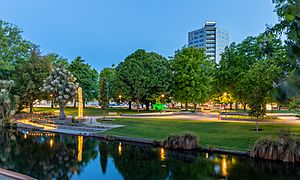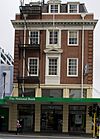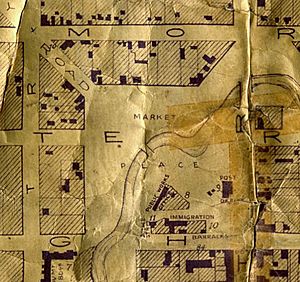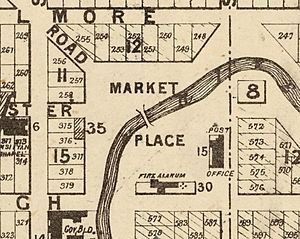Victoria Square, Christchurch facts for kids
Quick facts for kids Victoria Square |
|
|---|---|

Victoria Square in 2020
|
|
| Type | Public square |
| Location | Christchurch Central, Christchurch, New Zealand |
| Created | 1896 |
| Operated by | Christchurch City Council |
Victoria Square is a beautiful public park in central Christchurch, New Zealand. It was once known as Market Place or Market Square. In the past, people gathered here for market days, fairs, and trading. The area was redesigned into a park between 1896 and 1897.
After the big earthquake in February 2011, the square was in a special closed area called the Central City Red Zone. It reopened in November 2012. Some famous sights in Victoria Square include the Captain James Cook statue and the Queen Victoria statue. You can also see the H. L. Bowker Fountain and the Victoria Square Poupou. The park is also home to the country's oldest cast iron and stone bridge, now called the Hamish Hay Bridge.
Contents
Where is Victoria Square Located?
Victoria Square is one of four main squares in the Christchurch Central City. It is just north-west of the city's very center, Cathedral Square. Colombo Street runs north to south through Cathedral Square and forms the eastern edge of Victoria Square. Armagh Street borders the square on its southern side.
The Avon River flows diagonally through the square. In the early days, streets called Oxford and Cambridge Terraces ran along the river. Now, these streets stop before reaching Victoria Square. A road called Whately Road used to cut through the square. It was later renamed Victoria Street. This road was a major route leading north towards Papanui and other places. Other streets around the square are Kilmore Street to the north and Durham Street to the west.
Victoria Street was closed in 1988. This happened when the Parkroyal Hotel, later known as the Crowne Plaza, was built. Many people did not like this change. After the Crowne Plaza was taken down in 2011 and 2012 because of the earthquakes, some people wanted the road to be put back. This idea caused a lot of disagreement and was soon dropped.
A Look Back: History of Victoria Square
Early Days and Māori History
Between the years 1000 and 1500, the area where Victoria Square now stands was home to Puari. This was a settlement of the Waitaha people, an early Māori iwi (tribe). It is believed that at its busiest, this settlement or pā could hold about 800 people. Later, the Ngāi Tahu iwi used the river area for gathering food. They did not live there permanently.
Christchurch's Economic Center
When Christchurch was mapped out in March 1850, Cathedral Square was planned as the city's center. However, for many years, Market Place (Victoria Square) was the main economic hub. Important services were set up here. These included the first post office, the police station, and a simple jail. There were also work stores, places for new immigrants, and a market hall. A general store owned by George Gould faced Market Square on Colombo Street.
Bridges and Street Names
The very first simple bridge over the Avon River in the square was built in March 1852. It was called Papanui Bridge or Market Place Bridge. In September 1864, a stronger bridge was built to replace it. This new bridge was named Victoria Bridge. In October 1877, people asked the city council to rename Whately Road to Victoria Street, and the council agreed.
The Lock-up and a Party
In 1852, the Governor of New Zealand, George Grey, visited Christchurch. It was decided that the government would pay for a lock-up (a small jail). Isaac Luck built this structure. It was very small, only about 3 by 6 meters. It was finished by June of that year. A funny story that people often told was that after it was built, Luck held a party inside it for his friends!

Changes and New Buildings
A town planner named Professor Gordon Stephenson suggested closing Victoria Street through the square. The Christchurch Town Hall was built north of the Avon River, along Kilmore Street. It was designed by Sir Miles Warren and Maurice Mahoney in 1966. The plans included new city offices next to the town hall. However, the city council did not build these offices. Instead, they bought a department store and moved their offices there in 1980. This was much cheaper.
The Town Hall was badly damaged in the February 2011 earthquake. Its future was uncertain for a while. In August 2013, council staff suggested four ways to save the building. These options would cost about NZ$125 million.
The land that was supposed to be for the city offices was instead rented to a company. This company built a large hotel there. The Parkroyal Hotel was also designed by Warren and Mahoney. It became a very fancy hotel in Christchurch. The hotel was shaped like an "L" and had a large open space inside called an atrium. This was the biggest atrium built in New Zealand at the time. The hotel's name changed to Crowne Plaza in 2001. The Crowne Plaza was heavily damaged in the earthquakes and was taken down in early 2012.
Proposed Tower and Community Projects
In November 1986, a group of developers suggested building a 167-meter-tall tower. This tower would have a viewing platform and a spinning restaurant at the top. It would have been the tallest building in the South Island. It was planned for the area where Victoria Street used to be, at the corner of Colombo and Armagh Streets. This idea was very controversial and faced strong opposition. In April 1988, the project was canceled.
In late 2012, the old Crowne Plaza site was used by a group called Gap Filler. They built the Pallet Pavilion there. This was an outdoor space made by volunteers using wooden pallets. It was meant to be there only for the summer of 2012/13. But it became so popular that people raised money to keep it open through the winter of 2013.
Earthquake Impact and Redevelopment Plans
Victoria Square was one of the few places in the city center that was not completely destroyed by the 2011 Christchurch earthquake. In 2014, the Christchurch Central Development Unit announced plans to spend about NZ$7–8 million to redesign the square. This was part of a bigger project to improve the Avon River area. Many people were very upset about these plans. The government's announcement was not for public discussion, but just for information. People demanded to be consulted, but this was first refused.
In February 2015, the project was put on hold, and a public discussion period began. In July 2015, new plans were released. These plans suggested some repair work that would keep Victoria Square mostly the same.
In November 2014, a history professor named Geoffrey Rice wrote a book about Victoria Square.
What Can You See in Victoria Square?
Victoria Square has several important landmarks. These include the Captain James Cook statue and the statue of Queen Victoria. You can also find the H. L. Bowker Fountain and the Victoria Square Poupou, which is a Māori carving.
Historic Places Around Victoria Square
Victoria Square and its surroundings have many buildings, structures, and statues that are officially recognized as heritage items by Heritage New Zealand. Many of these were damaged in the February 2011 earthquake.
| Category | Name | Address | Status | Photo |
| II | Cook Statue | Victoria Square | Undamaged |  |
| II | Hamish Hay Bridge | Victoria Square crossing the Avon River | Under repairs |  |
| II | Queen Victoria Statue | Victoria Square | Undamaged |  |
| II | Armagh Street Bridge | Armagh Street, eastern crossing of the Avon River | Reopened in 2014 following repairs |  |
| II | Armstrongs Building | 91–107 Armagh Street | Demolished |  |
| II | Colombo Street Bridge | Colombo Street crossing the Avon River | Reopened in 2014 following repairs |  |
| II | Isaac House | 779 Colombo Street | Not in use; on land designated for the new Convention Centre |  |
| I | Magistrates Court | 85 Armagh Street | ? |  |
Images for kids



